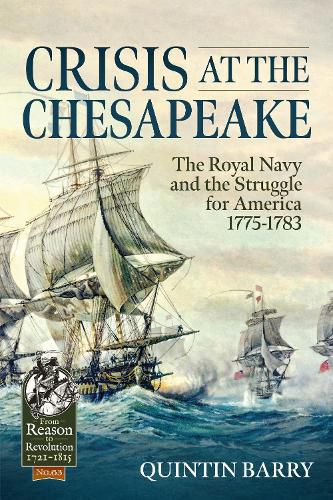Readings Newsletter
Become a Readings Member to make your shopping experience even easier.
Sign in or sign up for free!
You’re not far away from qualifying for FREE standard shipping within Australia
You’ve qualified for FREE standard shipping within Australia
The cart is loading…






An account of the crucial battle of Chesapeake Bay in 1781, and the events leading up to it. By the end of 1780 the war for American independence appeared to be approaching a stalemate. After five years of war, Washington’s armies remained in the field. Once France, and then Spain, joined the war, Lord Sandwich as First Lord of the Admiralty was faced with a constant struggle to balance the forces needed at home and overseas, while facing constant hostile pressure from the opposition. However, events were conspiring to bring about a showdown in North America, which would take place in the waters off Chesapeake Bay. This book describes how, step by step, the crisis was reached. After France had accepted the need for a major effort to support the Americans, Count de Grasse arrived in the West Indies in April 1781 with a large fleet, intending to arrive off the North American coast in July. Once he had opted to sail to Virginia, Washington began to move south. Meanwhile Lord Cornwallis, the British commander in the Carolinas, had chosen without authority to march to Virginia, where he arrived in May to link up with a force that had been sent to establish a naval base in the Chesapeake. De Grasse reached Chesapeake Bay with his whole fleet at the end of August, outnumbering the British fleet under Graves which arrived on 5 September. The battle that followed was indecisive, though the French had the best of it. Cornwallis was now besieged at Yorktown by Washington; a force intended to relieve him arrived too late and on 19 October he capitulated at Yorktown. The war for American independence was decisively lost; all that remained was a bitter debate as to who was to blame. AUTHOR: Quintin Barry is a retired solicitor and employment charge. He has also held a variety of offices in both public and private sectors including the NHS and local radio. Following a lifelong interest in history, he is the author of a number of books on military and naval history. These include an acclaimed two volume history of the Franco-Prussian war of 1870-1871, a history of the Austro Prussian War of 1866, and the first modern history of the Rosso Turkish war of 1877-1878. He has made a particular study of the life and career of Helmuth von Moltke. He has also written a biography of the 17th Earl of Derby. Among his recent books are:The War in the North Sea 1914-1918, Far Distant Ships, a history of theblockade of Brest during the Napoleonic wars, and a study of the naval operations of the Spanish-American War of 1898. 6 b/w images, 2 maps
$9.00 standard shipping within Australia
FREE standard shipping within Australia for orders over $100.00
Express & International shipping calculated at checkout
An account of the crucial battle of Chesapeake Bay in 1781, and the events leading up to it. By the end of 1780 the war for American independence appeared to be approaching a stalemate. After five years of war, Washington’s armies remained in the field. Once France, and then Spain, joined the war, Lord Sandwich as First Lord of the Admiralty was faced with a constant struggle to balance the forces needed at home and overseas, while facing constant hostile pressure from the opposition. However, events were conspiring to bring about a showdown in North America, which would take place in the waters off Chesapeake Bay. This book describes how, step by step, the crisis was reached. After France had accepted the need for a major effort to support the Americans, Count de Grasse arrived in the West Indies in April 1781 with a large fleet, intending to arrive off the North American coast in July. Once he had opted to sail to Virginia, Washington began to move south. Meanwhile Lord Cornwallis, the British commander in the Carolinas, had chosen without authority to march to Virginia, where he arrived in May to link up with a force that had been sent to establish a naval base in the Chesapeake. De Grasse reached Chesapeake Bay with his whole fleet at the end of August, outnumbering the British fleet under Graves which arrived on 5 September. The battle that followed was indecisive, though the French had the best of it. Cornwallis was now besieged at Yorktown by Washington; a force intended to relieve him arrived too late and on 19 October he capitulated at Yorktown. The war for American independence was decisively lost; all that remained was a bitter debate as to who was to blame. AUTHOR: Quintin Barry is a retired solicitor and employment charge. He has also held a variety of offices in both public and private sectors including the NHS and local radio. Following a lifelong interest in history, he is the author of a number of books on military and naval history. These include an acclaimed two volume history of the Franco-Prussian war of 1870-1871, a history of the Austro Prussian War of 1866, and the first modern history of the Rosso Turkish war of 1877-1878. He has made a particular study of the life and career of Helmuth von Moltke. He has also written a biography of the 17th Earl of Derby. Among his recent books are:The War in the North Sea 1914-1918, Far Distant Ships, a history of theblockade of Brest during the Napoleonic wars, and a study of the naval operations of the Spanish-American War of 1898. 6 b/w images, 2 maps